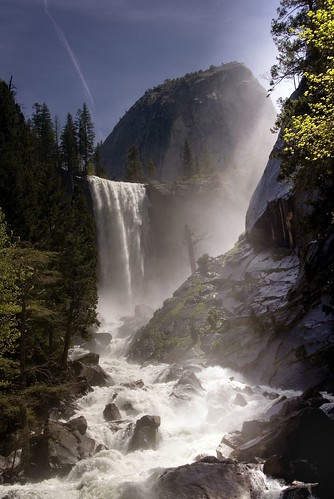
Death Valley Sunrise 2, photo by Harold Davis. View this photo larger. I originally blogged this photograph here.
In the 1980s, when I was a photographer based in New York City, I was a member of an organization that went by the acronym ASMP. (If you are interested, here are some of my photos of the World Trade Towers taken during that era.)
Back then, ASMP was short for American Society of Magazine Photographers, and the organization was based in New York. The world has moved on, and today ASMP is based in Philadelphia and the abbreviation is short for American Society of Media Photographers.
I’ve become active enough again in photography that I recently thought to join back up with ASMP. I noted on ASMP’s website the following criteria for general membership:
Photographer must be actively and professionally engaged in publication photography with three or more consecutive years of substantial publication experience from date of first published work. This publication record must generate the major source (over 50%) of earned income.
A few of my photographs are still in print after more than twenty-five years, and I make a little money from them. I make some money from my current books that are about (or include) photographs, and I generate revenue from this photoblog. But obviously, even leaving aside investment income, I make more money from general writing and consulting than I do from photography. I’d like to make more money from my photographs than I do (if you can help with this, please contact me!). That said, I’ve really enjoyed not having to depend on photography for the bulk of my living (or to support my expanding family) as I’ve eased back into photography. Does this make me less a media photographer?
I decided honesty was the best policy, and I wrote Eugene Mopsik, the executive director of ASMP as follows:
I’m interested in rejoining ASMP. I was a general member from about 1980 to 1990 (I’m not sure of the exact years) when I worked out of my New York studio.
At this point, I can’t say that I make the bulk of my living from photography (my primary income sources are writing and consulting). But I do have quite a few recent publication credits, including the book “Digital Field Guide” (published in 2005 by Wiley), a book contract with W.W. Norton for “Photographer’s Guide to Yosemite” … .
Mr. Mopsik replied :
If the primary source of your income is not the sale or license of your images, then you do not qualify for General membership. I have no room to make exceptions.
Now, ASMP has the right to establish whatever membership criteria they’d like. But this seems like a strangely rigid policy in a time of career fluidity in the face of the changes wrought by digital photography. Reversing Groucho Marx’s dictum that “I don’t care to belong to any club that will accept me as a member,” I no longer have much enthusiasm for re-joining ASMP, which seems to me a fairly two-bit operation these days. I’m trying not to be egocentric about this, but there is something pretty strange about any professional photography organization that doesn’t want me as a member.
View this photo larger. I originally blogged this photograph here.
The exchange with ASMP brings up a bigger question in my mind: what is a photographer? I’m not asking this question in the reductive sense that could be answered “someone with a camera who takes pictures.” Nor does ASMP’s someone who “makes more than 50% of their earned income from photography” seem particularly helpful—although it does seem vulgar and peculiarly American in its conflation of revenue with professionalism.
When I was a photographer the first time round, and depending on my income as a photographer to pay the rent, I took any number of commercial assignments that I don’t think served my photography particularly well. I sold a great many prints as “corporate art,” which may not have been the best thing for me as an artist. Of course, you do what you have to do—and there’s nothing wrong with making money from photography as long as the process of being commercial doesn’t contradict the reason for photography.
Even taking those who are literally dependent on photography for the bulk of their “earned income,” the umbrella of photographer covers a huge number of different kinds of businesses. A wedding photographer is doing something very different from an advertising photographer, or a photojournalist.
I recall that in a night-long bull session with Ansel Adams, the great photographer told me proudly in his time that he had accepted any photography assignment that came along—including some pretty low-rent projects. Of course, by the time I knew Adams his days of this kind of thing were long in the past. And I doubt he was ever a terribly good product photographer.
View this photo larger. I originally blogged this photograph here.
It’s hard to quarrel with Adams’s magisterial technique and the grandeur of his subject matter. The only possible critique is that the images create an emotional epiphany based on false premises—these are places in a park, wrested away from the original inhabitants, not a true spiritual wilderness. Still, a print of Adams’s Moonrise over Hernandez in the collection of the Museum of Modern Art is what got me started on my career as a photographer back when I was a teenager.
Whatever detours into commercial photography Adams may have made, these did not inform his real work. (Whether they actually detracted from it ultimately is another question, and one that am I undecided about.)
You can do advertising, or weddings, or products, or photojournalism and be a hack. You can also do advertising, or weddings, or products, or photojournalism, or write, or many other things, and also be a real photographer.
So what is a real photographer? Here are my thoughts.
A real photographer understands the techniques and technicalities of photography, and the image-making process. Back when I had my first photography career, this meant knowing about cameras, lenses, film, darkrooms, and all that stuff. Today, this means understanding cameras, lenses, digital workflow, the RAW file format, and how to prepare images in Photoshop. The subject matter changes, but the level of knowledge and attention to detail required does not.
A photographer is a craftsperson.
A photographer has a good eye, looks at the world in an original way, and knows how to capture that original vision as a two-dimensional image.
A photographer behaves professionally, and with integrity. He does not lie or manipulate, and uses his photographs for purposes of good, not evil.
A photographer cares about what he photographs, and that empathy can be seen in his imagery.
A photographer understands light, color, focus, shadow, and composition.
A photographer is like a knight on a quest. Even the goal of the quest may not be entirely clear. The photographer goes forth, in whatever milieu is most his own, and takes the adventure that is given to him. He may succeed and bring back great images, or more likely not, but the point is not the goals and results but rather the journey.

